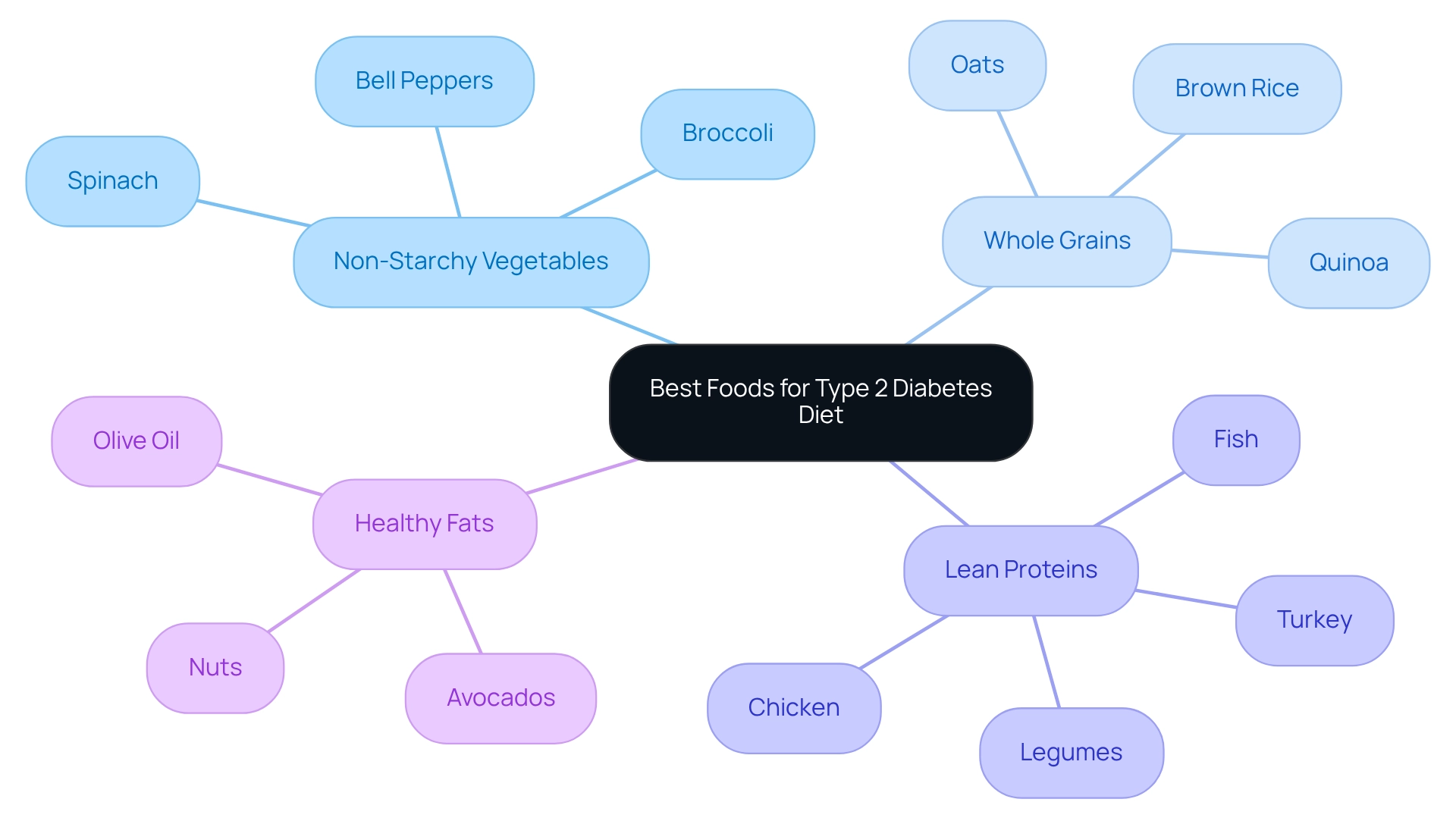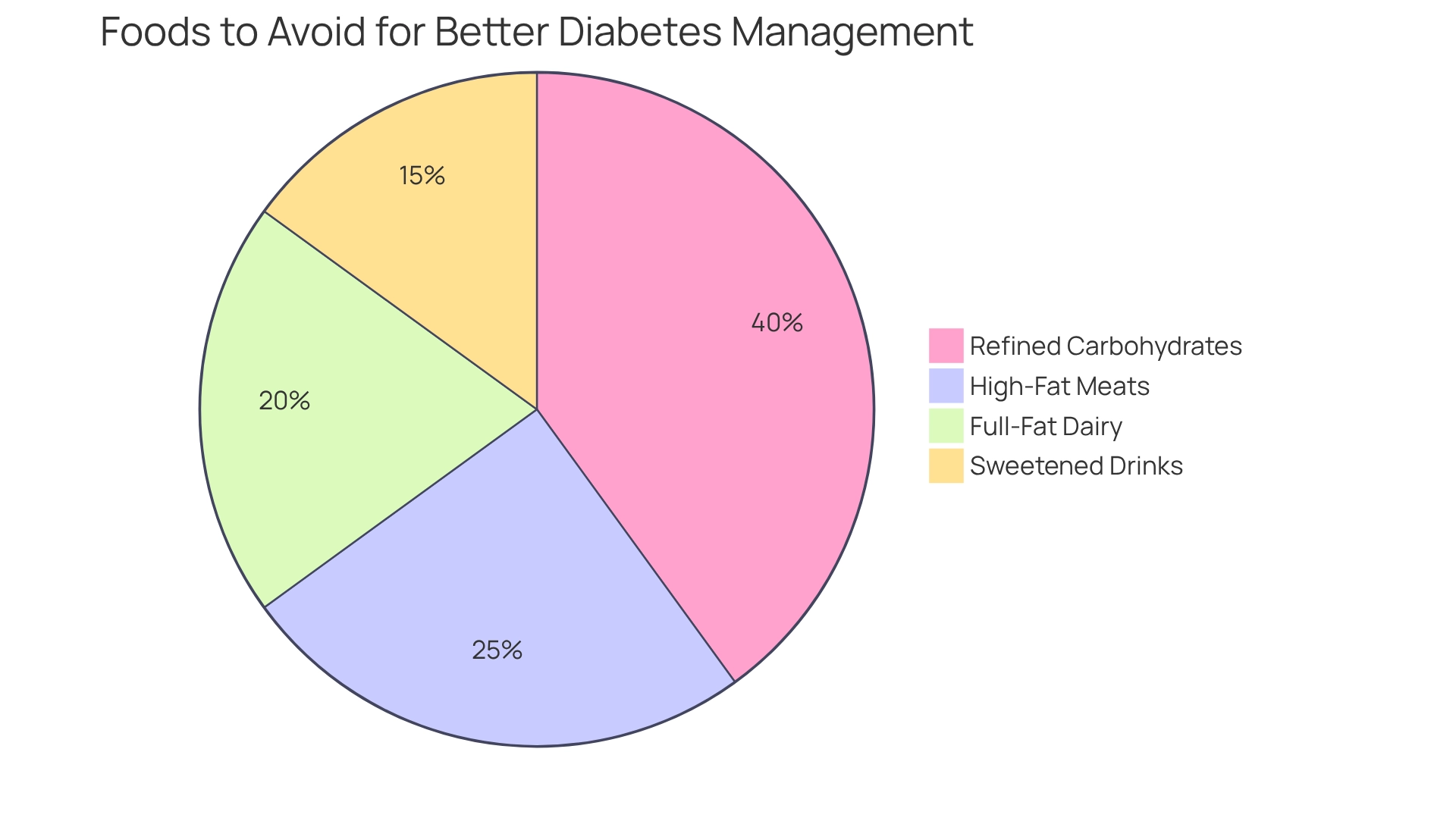Overview
If you're navigating the journey of managing Type 2 Diabetes, it's essential to know which foods can support your health. Non-starchy vegetables, whole grains, lean proteins, and healthy fats are key choices that not only help control blood sugar levels but also provide vital nutrients. It's understandable to feel overwhelmed by dietary changes, but focusing on a balanced diet with low glycemic index foods and regular meal timing can significantly enhance your glucose management and overall well-being.
Research and expert recommendations support this approach, reassuring you that you're not alone in this journey. Remember, small steps can lead to meaningful changes. Consider reaching out for resources or support to help you along the way. You deserve to feel empowered and informed as you take charge of your health.
Introduction
In the journey of managing Type 2 Diabetes, understanding your dietary needs is vital. It’s completely normal to feel overwhelmed by the array of food choices available. With a focus on stabilizing blood sugar levels and promoting your overall health, this article will guide you through the essential components of a diabetes-friendly diet.
We will highlight the importance of:
- Whole foods
- Low glycemic index options
- Balanced nutrition
You’ll discover which foods to embrace and which to avoid. Additionally, we’ll explore how strategic meal timing can enhance your blood sugar control.
By equipping you with practical knowledge and insights, this guide aims to empower you to take charge of your health. Remember, you’re not alone in this journey; we are here to support you every step of the way as you work to improve your quality of life.
Understanding the Dietary Needs for Type 2 Diabetes
Living with Type 2 Diabetes requires attention to type 2 diabetes food to eat that focuses on controlling glucose levels while nurturing overall well-being. Embracing a balanced diet filled with whole foods, fiber, and healthy fats is essential when considering type 2 diabetes food to eat. While carbohydrates are important for energy, they need to be monitored closely to prevent spikes in glucose levels. Choosing type 2 diabetes food to eat that has a low glycemic index (GI) can be beneficial, as they release glucose slowly into the bloodstream, helping maintain stable blood sugar levels. Additionally, incorporating enough protein and healthy fats can promote feelings of fullness and nutritional balance.
Understanding these dietary requirements is vital for effectively managing blood sugar levels and enhancing your quality of life. It’s important to recognize that, as the CDC notes, 'individuals with this condition are twice as likely to experience depression as those without it.' This highlights the need to address mental well-being alongside physical health through nutrition. Furthermore, the prevalence of diabetes among Hispanic and Latino adults ranges from 5.0% to 7.3%, underscoring the importance of culturally sensitive dietary strategies.
Corporate wellness programs that tackle this health issue have shown that providing employees with nutritional guidance and support can significantly improve health outcomes and productivity. For instance, these initiatives can lead to better management of diabetes, which is crucial given that the additional medical expenses associated with this illness increased from $10,179 in 2012 to $12,022 in 2022. By understanding and implementing these dietary needs, including type 2 diabetes food to eat, you can take meaningful steps to enhance your diabetes management and overall quality of life. Remember, you're not alone in this journey; seeking support and resources can make a world of difference.

Best Foods to Include in a Type 2 Diabetes Diet
A well-rounded diet consisting of type 2 diabetes food to eat should prioritize non-starchy vegetables, whole grains, lean proteins, and healthy fats. Non-starchy vegetables like spinach, broccoli, and bell peppers are not only low in calories but also filled with vital nutrients, making them perfect for managing glucose levels. By incorporating these vegetables into your meals, you can significantly enhance your nutrient intake without adding excess calories.
Whole grains such as quinoa, brown rice, and oats are rich in fiber, which plays a crucial role in digestion and blood sugar regulation. Research indicates that individuals who consume whole grains regularly experience better glycemic control. This highlights their importance in a diabetes-friendly diet, and you're not alone in seeking ways to improve your health.
Lean proteins, including chicken, turkey, fish, and legumes, are vital for maintaining muscle mass and promoting satiety, which can help prevent overeating. Additionally, nutritious fats from sources like avocados, nuts, and olive oil contribute to heart wellness, an important factor for anyone overseeing their blood sugar.
Experts recommend including non-starchy vegetables in every meal. A registered dietitian observes, "Through Self-Management Education and Support (SMES), you'll collaborate with a health educator to develop a nutritious meal plan tailored specifically for you." This personalized approach ensures that your dietary choices align with your individual health goals, reinforcing that you are supported in this journey.
Including type 2 diabetes food to eat in your everyday meals not only promotes improved health results but also encourages a proactive method for managing blood sugar levels. Case studies have demonstrated that individuals who follow a nutritious, balanced diet significantly lower their risk of serious health complications linked to poorly managed blood sugar levels. Remember, consistent tracking of glucose readings is essential; it assists you in understanding how various foods influence your glucose amounts, leading to more knowledgeable dietary decisions.
You're not alone in this journey. We are here to support you every step of the way.

Foods to Avoid for Effective Diabetes Management
Managing your condition can feel overwhelming, but understanding what to avoid can make a significant difference. It's important to steer clear of certain foods that can negatively impact your sugar levels. Refined carbohydrates, like white bread, pastries, and sugary snacks, can be especially troublesome as they often lead to rapid spikes in glucose levels.
High-fat meats and full-fat dairy products may also contain unhealthy fats that can worsen insulin resistance. This makes them less suitable for those of us managing diabetes. Sweetened drinks, such as soda and fruit juices, should be limited too, as they provide little nutritional value and can cause significant rises in glucose concentrations.
For instance, did you know that a 12-ounce fruit smoothie can contain as much as 52 grams of carbohydrates, including 44 grams of sweeteners? This highlights the importance of tracking nutrition information to help you manage your carbohydrate intake effectively.
As health coach Lynn Grieger wisely advises, "To enjoy a truly healthy oatmeal, choose plain steel-cut or old-fashioned oatmeal and add your own fruit and a bit of cinnamon for sweetness." This simple tip emphasizes the significance of choosing whole, unprocessed foods that support stable glucose levels.
By consciously avoiding these less healthy options and incorporating more nourishing choices like oatmeal, you can enhance your diabetes management by choosing type 2 diabetes food to eat and lower your risk of complications. Remember, you're not alone in this journey, and we are here to support you every step of the way.

The Role of Meal Timing in Blood Sugar Control
Meal timing plays a crucial role in managing glucose levels for those living with Type 2 Diabetes. It's important to understand that consuming food at consistent intervals can help maintain stable glucose concentrations. Many healthcare professionals recommend enjoying three balanced meals each day, along with healthy snacks in between if you feel the need.
It's also worth noting that the timing of your meals can impact insulin sensitivity. For example, research indicates that eating breakfast earlier in the day may lead to improved glucose control. You're not alone in navigating these dietary choices; understanding the relationship between meal timing and blood sugar levels can empower you to make informed decisions that enhance your diabetes management.
If you're feeling overwhelmed, remember that support is available. Consider reaching out to a healthcare professional for personalized guidance tailored to your unique needs. Together, we can work towards a healthier future.

Conclusion
Managing Type 2 Diabetes effectively revolves around understanding and implementing a diabetes-friendly diet. By prioritizing whole foods, low glycemic index options, and balanced nutrition, you can significantly impact your blood sugar levels and overall health. Incorporating non-starchy vegetables, whole grains, lean proteins, and healthy fats into your daily meals not only supports glycemic control but also promotes your overall well-being.
It's equally important to avoid specific foods that can hinder your diabetes management. Refined carbohydrates, high-fat meats, and sugary beverages can lead to detrimental spikes in blood glucose levels. By consciously steering clear of these options and opting for healthier alternatives, you can take significant steps toward better health outcomes.
Additionally, the timing of your meals plays a critical role in blood sugar regulation. Regular meal intervals and strategic timing can enhance insulin sensitivity and maintain stable glucose levels. By understanding and applying these principles, you can empower yourself to make informed dietary choices that contribute to your quality of life.
Ultimately, this journey requires a combination of education, support, and personal commitment. With the right dietary strategies in place, you can navigate the complexities of managing Type 2 Diabetes with confidence and resilience. Remember, you’re not alone in this journey; we are here to support you every step of the way, leading to improved health and a brighter future.
Frequently Asked Questions
What dietary considerations are important for individuals with Type 2 Diabetes?
Individuals with Type 2 Diabetes should focus on a balanced diet that includes whole foods, fiber, and healthy fats while closely monitoring carbohydrate intake to prevent spikes in glucose levels.
Why is the glycemic index (GI) important for Type 2 Diabetes management?
Foods with a low glycemic index release glucose slowly into the bloodstream, helping to maintain stable blood sugar levels, which is beneficial for managing Type 2 Diabetes.
How do protein and healthy fats contribute to a diabetes-friendly diet?
Incorporating enough protein and healthy fats can promote feelings of fullness and provide nutritional balance, which is important for overall well-being.
Why is it important to address mental well-being in individuals with Type 2 Diabetes?
Individuals with Type 2 Diabetes are twice as likely to experience depression compared to those without the condition, making it essential to address mental health alongside physical health through nutrition.
What is the prevalence of diabetes among Hispanic and Latino adults?
The prevalence of diabetes among Hispanic and Latino adults ranges from 5.0% to 7.3%, highlighting the need for culturally sensitive dietary strategies.
How can corporate wellness programs assist individuals with Type 2 Diabetes?
Corporate wellness programs that provide nutritional guidance and support can significantly improve health outcomes and productivity for employees managing diabetes.
What has been the trend in medical expenses associated with diabetes from 2012 to 2022?
The additional medical expenses associated with diabetes increased from $10,179 in 2012 to $12,022 in 2022, underscoring the financial impact of the illness.
What steps can individuals take to enhance their diabetes management?
Individuals can enhance their diabetes management by understanding and implementing dietary needs, seeking support and resources, and making informed food choices.



